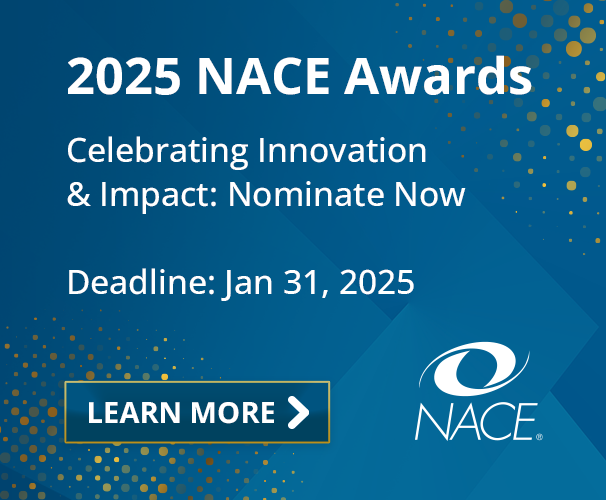Spotlight for Career Services Professionals
Because career fairs typically require a considerable investment of time and resources to be successful, it is important for career centers to track and analyze data about these events to understand their effectiveness.
The shift to the virtual space has allowed for collection of career fair data that may have been out of reach with the traditional format.
“Even in the virtual space, planning logistics, partnering with employers, and engaging students can require significant effort,” explains Abdullah Abdul Kader, assistant director, Texas A&M University Career Center.
“Therefore, it is important for career centers to collect data and analyze metrics to determine return on investment for these large programs. Data provide much better insight on attendance, behavior, and ROI. Because these events require time, effort, and financial support to plan and execute, it is important to have the ability to measure their effectiveness, which is not otherwise possible.”
Beyond ROI, collecting attendance and engagement data can be helpful to recruiting organizations in subsequent years as career centers can provide more insight regarding the total numbers of students as well as the demographics of students who attend these programs.
Career centers that do not collect and analyze data from their career fairs are unable to make objective or data-driven decisions when it comes to allocating resources, running targeted student/employer campaigns, and identifying tangible improvement opportunities.
There are several challenges associated with collecting data from traditional career fairs that have been alleviated by the shift to virtual fairs.
“Virtual career fairs require registration, and students must log in to access the event, providing much more reliable and valid attendance data,” says Samantha Wilson, executive director, Texas A&M University Career Center.
“In addition, depending on the virtual career fair platform used, we can assess the number of companies visited and length of conversations, something that is not possible when fairs are hosted in the physical space. In a physical setting, even when we are able to track the overall attendance at a fair, it only shows how many students checked in at the entrance; we are unable to learn how many of those students talked to an employer and how many employers were interacted with on average. We are also unable to gather how many students visited each of the employers and what the demographics of those students were.”
Furthermore, because the virtual format allows career centers to track interactions and the duration of conversations during the fair, they are able to determine the level of activity and areas of interest.
Efforts to collect and analyze career fair data yield other valuable results. Abdul Kader points out that being able to share attendance data and level of activity, and identify areas of focus for future fairs, including targets for increased marketing and outreach, are crucial areas that this insight can help improve.
“To get the most out of this data, we must be able to make sense of it to pursue questions, uncover patterns of interest, and identify—and potentially correct—errors,” he says.
“We were able to understand the average chat time and average number of chats by a student at each career fair by major, degree, work authorization, and more. We used to share qualitative data based on student feedback on average chat times and number of companies to target at the fair, but virtual fairs have provided us hard, reliable data. We have also been able to run targeted campaigns to increase employer registration at career fairs as well as participation at other events.”
Using its virtual career fair platform, Texas A&M captured career fair engagement data at a more granular level than was previously available from 25 career fairs over 33 career fair days during fall 2020 and spring 2021. In fall 2020, for example, Texas A&M career fairs had more than 12,700 attendees and more than 4,100 representatives. This includes more than 8,000 unique students, more than 3,200 unique recruiters, and more than 900 companies, resulting in 43,000-plus chats.
These 33 individual career fair reports were then combined using data visualization software to display key performance indicators in an interactive dashboard. The dashboard is published to the cloud, which helps maintain consistency in reporting while making it accessible.
“Managing, creating, and sharing consistent reports to stakeholders can be a resource-intensive activity, requiring a significant amount of modifications and upkeep,” Wilson says.
“However, developing these dashboards allows us to simplify the reporting process, provides an interactive tool to customize data reports, and promotes use through more visually engaging presentations of data.”
Abdul Kader and Wilson recommend that career centers conduct an exploratory data analysis as a first step in their career fair data collection and analysis initiative.
“When we look at raw data, we don’t always know the insights hidden in the data,” Wilson explains.
“With exploratory data analysis, the idea is to start with simply visualizing the various relationships using the data points available. This will help get some ‘big picture’ understanding and maintain an objective approach toward analyzing the data in its entirety.”
Adds Abdul Kader: “Oftentimes, we look at data and jump into making assumptions regarding what to focus on and what insights to look for. Instead of doing this, if we simply start looking for patterns, relationships, anomalies, outliers, and a summary of statistics, we can uncover additional insights.”
It is important for career centers to determine what data will be of use to them, what questions have they had about career fairs, and if they have a hypothesis they want to test on the data. Some examples of information that can be extremely helpful in planning future events are:
- Who is attending the career fairs?
- Who are those students interacting with most?
- Are there certain groups of students who should be engaging in career fair activities, but are not attending?
- How do we increase the engagement of these students?
“Begin with the end in mind and determine what data is most important to you and start collecting it,” Abdul Kader recommends.
“There will always be more metrics you can assess, but you only want to collect data that you will use.”
Wilson adds that it is not necessary to have a robust infrastructure in place for data collection or analysis in order to get started.
“It’s good to start by identifying the most important and the easiest data points to collect and then implement the steps necessary to gather that information,” she says.
“Also, your colleagues on your campus and in other career centers can be a resource to you and can help accelerate your progress, so don’t hesitate to ask for help.”
Abdullah Abdul Kader and Samantha Wilson of Texas A&M University presented “Data Analytics for Virtual Space: Maximize Insights From Virtual Career Fair Data” during NACE21.




